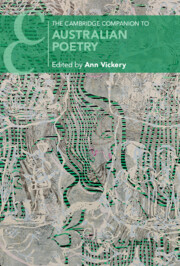Book contents
- The Cambridge Companion to Australian Poetry
- The Cambridge Companion to Australian Poetry
- Copyright page
- Contents
- Figures
- Contributors
- Acknowledgements
- Chronology
- Introduction
- Part I Change and Renewal
- Part II Networks
- Part III Authors
- 9 High Delicate Outline
- 10 Burning Sappho
- 11 Les Murray
- 12 Lionel Fogarty’s Poetics of Address and the Negative Lyric
- Part IV Embodied Poetics
- Part V Expanding Form
- Further Reading
- Index
- Cambridge Companions To …
- References
9 - High Delicate Outline
The Poetry of Judith Wright
from Part III - Authors
Published online by Cambridge University Press: 06 June 2024
- The Cambridge Companion to Australian Poetry
- The Cambridge Companion to Australian Poetry
- Copyright page
- Contents
- Figures
- Contributors
- Acknowledgements
- Chronology
- Introduction
- Part I Change and Renewal
- Part II Networks
- Part III Authors
- 9 High Delicate Outline
- 10 Burning Sappho
- 11 Les Murray
- 12 Lionel Fogarty’s Poetics of Address and the Negative Lyric
- Part IV Embodied Poetics
- Part V Expanding Form
- Further Reading
- Index
- Cambridge Companions To …
- References
Summary
This chapter traces the development of Judith Wright’s poetics, outlining her early focus on specific places and their legacies rather than on ideas of nation. It offers close readings of poems like “South of My Days,” “Bullocky,” and “Bora Ring.” The chapter then identifies mid-career attention to interpersonal relations before considering Wright’s growing awareness of settler-colonial privilege, Aboriginal sovereignty, different orders of temporality, and a continued expression of love for the land. The chapter reflects on the impact of Wright’s friendship with Aboriginal poet Oodgeroo Noonuccal and analyses “Two Dreamtimes.” It also examines Wright’s decision in 1990 to forego writing poetry in order to embrace environmental activism.
- Type
- Chapter
- Information
- The Cambridge Companion to Australian Poetry , pp. 153 - 166Publisher: Cambridge University PressPrint publication year: 2024

